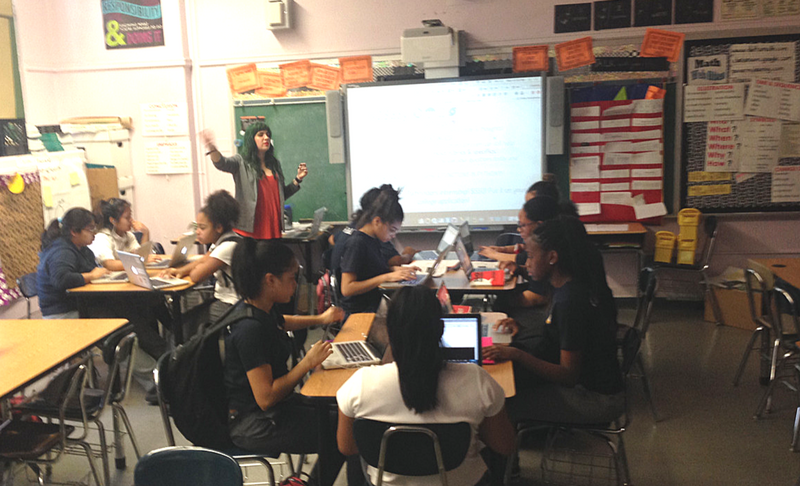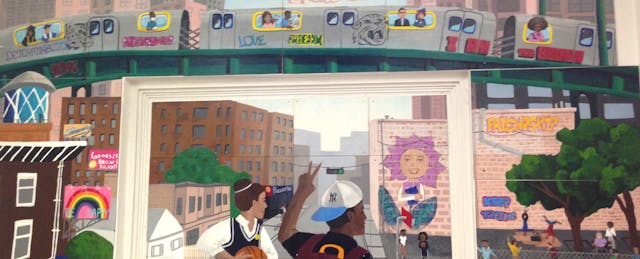Walking up to the Young Women’s Leadership School (YWLS) in the Bronx, there is a barbershop and a few run down bodegas. A group of young men in front of a residential building exchange what appears to be marijuana joints. It's not the first place you expect to find a pioneer education program, but the Young Women’s Leadership School is one of the city’s first public schools to have a full computer science (CS) course.
The CS courses are funded and designed by the Computer Science for All initiative—a program in Mayor Bill de Blasio’s Equity and Excellence agenda run by the New York City Department of Education (NYCDOE).
“We have done a lot of quizzes and equations. Now I can program Python to do my math homework for me,” exclaims Franchesca, a YWLS ninth grader. Franchesca is one of the first students to take the new Software Engineering Program (SEP class) at her school. For her, programming comes easy. "It's fun to be able to control things," she says as she scrolls through her code, showing off her creations.

Courtney Morgan, Franchesca's teacher at YWLS, is currently going through the NYCDOE’s CS teacher training program. "All of my friends in STEM [science, technology, engineering, math] are white men, so it has been hard to get people to talk to the students. It’s nice when they get to see themselves in things.” Her class is full of black and Latino/Hispanic girls, and for Morgan, it is important that students like technology and learn to apply it to their daily lives.
“So many of my girls came in with a horrible mindset about math. These are a lot of the same concepts, but because they have never done this before they don't have a negative mindset yet,” she says.
Students in schools with the SEP program begin by learning block-based programming languages like Scratch before getting into robotics, physical computing, text-based programming like Python and web development. Computer science is a class SEP students attend daily and is a required core subject. Students can also participate in multi-year CS courses, where each class project is expected to correlate with a competency or standard set by the teacher. “Because we think of computer science as inherently project-based, they are creating and doing as they learn,” says Debbie Marcus, Executive Director of Computer Science Education at the NYC Department of Education.
Who’s Actually Teaching Computer Science?
Right now, only about 250 of the city’s 1,800 schools have begun teaching computer science or concepts surrounding the topic. However, with goals to reach all of the city’s 1.1 million students with at least one unit of computer science by 2025, the department is ramping up teacher training—offering current public school teachers per diem or per session to participate. To fund this, the city’s Computer Science for All initiative currently seeks to secure an $81 million-dollar budget—which will be spent over the course of ten years—through a combination of public and private funds.
"We have seen a lot of enthusiasm from teachers," says Marcus, explaining her department’s elaborate plans to train 4,775 of the city’s 70,000 K-12 teachers. "We teach them the content of computer science and a lot of the pedagogy around project-based learning. They brought so much of their own expertise to it that is has grown beyond what we could imagine.”
To support its goal of preparing more than 4,000 educators to teach computer science by 2025, Marcus’s department has partnered with programs like Code.org and Sunset Spark. Teachers can opt into the NYCDOE’s intensive training courses that last for weeks or gain an introduction through day-long workshops. "There’s an intimidation factor for teachers who think that this isn't for them. We started holding these one-day workshops to demystify computer science. We let them know there are no stakes involved if they just try it," says Marcus.

With public schools varying in mission and curriculum, implementation of the computer science training looks drastically different across the district. Many of the participating teachers are taking an interdisciplinary approach to the subject, introducing it as part of math or art classes already available. "We had a great art teacher in our first cohort who started doing color theory and ‘binary’ together,” says Marcus, “She taught color theory using a programming language called Processing.”
This type of computer science subject integration could be good news for educators seeking a flexible way to add CS to their existing curriculums, but for evaluators assessing competencies and standards, this could be problematic. "New York State doesn’t have computer science standard requirements. We are in the process of building what we would call a blueprint for CS education. The plan will define the foundational concepts and practices that every student needs to know," says Marcus. The department expects to release this blueprint by the summer.
In addition to equitable standards, education evaluators and researchers are calling on the district to ensure that their innovation initiatives are sustainable. “There has to be an infrastructure to make this happen and sustain it over time,” says Adriana Villavicencio, deputy director of the Research Alliance for New York City Schools at NYU Steinhardt. “It can't just be the individual or political will of one group of people. Funding sources do run out, so you must make this part of a system, not just an add-on." Villavicencio’s team secured a $5 million grant to evaluate the Computer Science for All program independently and is working closely with the NYCDOE to provide them with regular feedback.


